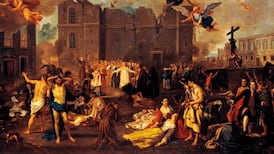WITH another ritual confrontation apparently inevitable on the Ormeau Bridge in Belfast tomorrow, and the political barometer plummeting, the North is facing the prospect of a summer of discord and tension.
The Easter Monday riots, after Orangemen were prevented from marching past the lower Ormeau nationalist district, have set the scene for numerous similar clashes in coming months.
The coming elections and promised negotiations seem fated to be framed in a context of inflamed tempers, tribalism and public disorder.
The political establishment has shown no stomach for taking a firm grasp of the issues raised by contentious parades, and it seems inevitable that the RUC will again be saddled with the task of handling each situation ad hoc.
The police are compelled to stand between two polarised factions, each of which has long memories of previous incidents and confrontations and is determined not to yield an inch.
On the Ormeau Road, as elsewhere, the RUC is required to apply the law as it exists. The Public Order (NI) Order, 1987, is the legal provision under which the police impose conditions on a parade if it is judged to threaten to cause serious disorder, property damage or disruption to the life of the community, or if the purpose of those organising it is to intimidate or to force or prevent people's actions against their will.
A senior police officer may impose "such conditions as appear necessary", and these can include conditions as to the route, or prohibiting the parade from entering any specified place.
These powers should be adequate to prevent trouble if police decisions were accepted by both sides. But operational decisions are based on a judgment or interpretation of circumstances, and both Orangemen and nationalists have repeatedly gone to the brink in challenging the validity of police decisions.
The Northern Secretary alone has the more sweeping power actually to ban marches, and there, may well be political pressure for the imposition of a blanket ban on parades for the duration of the electoral and talks process now pending.
It is a fine judgment, however, whether such a course of action could be enforced without the deployment of massive resources.
The Deputy Chief Constable of the RUC, Mr Ronnie Flanagan, comments: "If the law does, not meet people's expectations, or if the law is thought to be inadequate or in need of change, then that is a matter for the people and for parliament."
Political decisions will be unavoidable if the situation on the streets becomes patently out of hand. But the experience of last year's marching season with its multiple clashes, disturbances and bloodshed produced no decisive action or new policy measures.
THE scale of the problem is difficult to measure, but clearly the hope, that it will diminish or disappear is futile. One estimate which has emerged from Orange quarters is that, of approximately 2,700 Orange parades, only about 40 are contentious.
This estimate seems questionable, as at least 12 parades were scheduled for the Ormeau Road flashpoint alone this year, and multiple marches are expected in each of the many rural villages where there has been trouble in the past.
The issue of contentious parades has been discussed frequently at the Anglo Irish Secretariat at Maryfield, and a unionist councillor has recently asserted that the Government has given the Northern Ireland Office a list of 14 Orange parades it wants banned or rerouted.
However, apart from the major set piece events in Belfast and Derry which are a source of contention each year, it is unlikely that an arbitrary list of troublespots would define the problem.
It could be argued that the tensions frustrated by isolating those would simply re emerge at other points where relationships have been uneasy but contained.
After last year's troubles, the Grand Orange Lodge of Ireland issued a paper which examined some of the issues from that organisation's perspective. It made some tentative suggestions without executive force, about the type of music played at parades keeping parade "followers" away from sensitive areas, and reconsidering the use of sectarian lettering such as "UVF" or "UFF" on drums.
However, the thrust of the paper was to label most protests against Orange parades as republican inspired and stand firm on the demand for the retention of "traditional routes".
Two major new factors will colour community attitudes and behaviour at the most contentious parade venues this year. One is the recent history of the lower Ormeau Road situation.
Last year, with local opposition, becoming more organised and determined, the RUC blocked most of the approximately 16 marches, planned through the area, but forced a passage through for Orange parades on July 12th and August 12th.
In each case there was serious trouble, and it appears inevitable that, if a similar policy is applied this year, larger scale resistance will be encountered.
The second key factor is the so called spirit of Drumcree, which emerged from the prolonged stand off between Orangemen and the police over the rerouting of a parade due to pass along the Garvaghy Road.
THE Drumcree stand off, although it ended in a compromise, was promoted as a signal victory for Orange determination, and enhanced the status within unionism of several political figures who participated. It was undoubtedly a major factor in securing the UUP leadership for Mr David Trimble, and he has already signalled his intention of attending the venue again this year.
The scene is set for another ritual test of strength.
The parades issue, allowed to continue unresolved for so long, will take precedence over constitutional debate and could dominate the forthcoming election campaign, inflaming divisions to the detriment of the all party negotiations and the hopes for agreement and accord.








